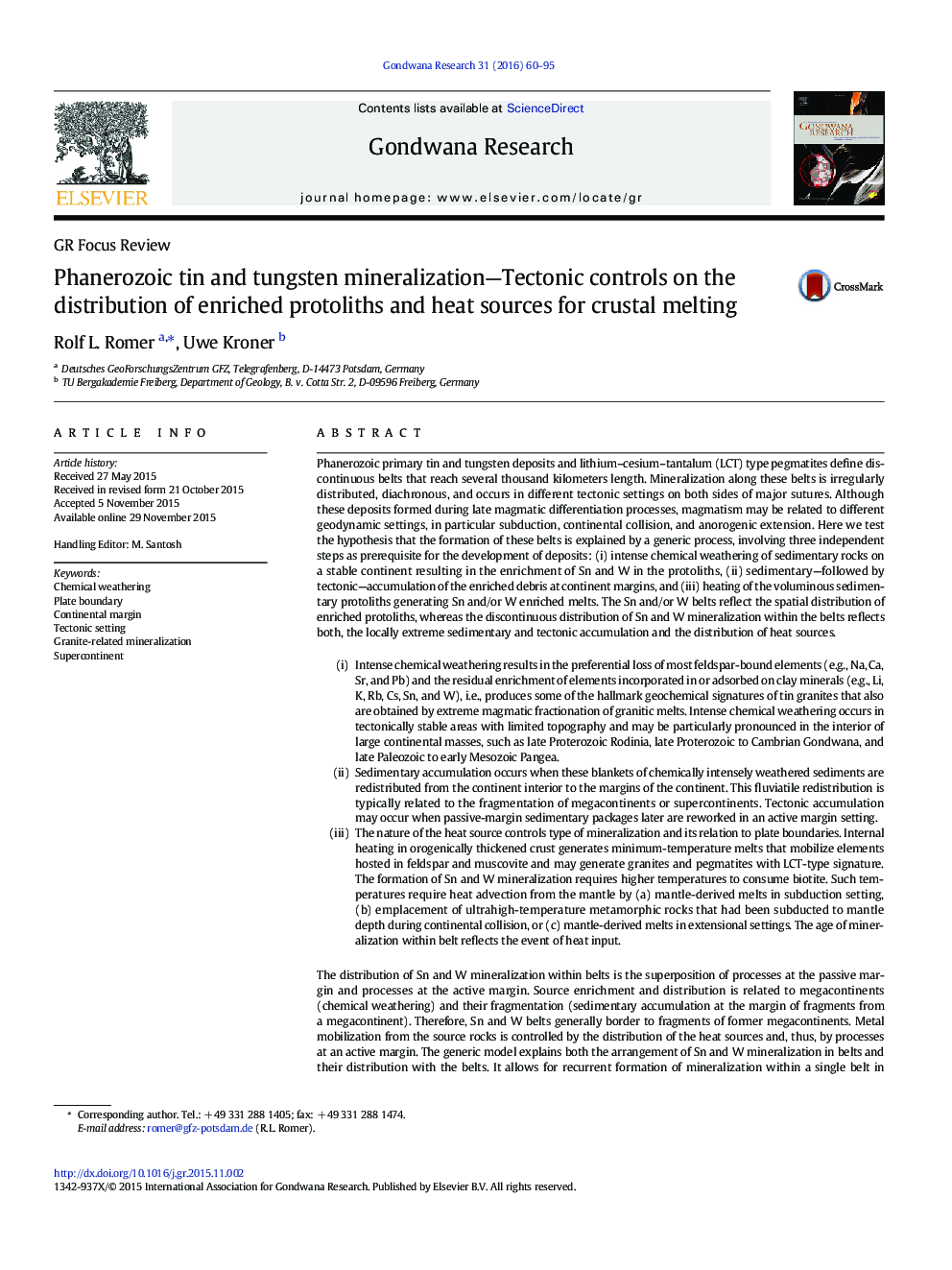| کد مقاله | کد نشریه | سال انتشار | مقاله انگلیسی | نسخه تمام متن |
|---|---|---|---|---|
| 4726673 | 1640140 | 2016 | 36 صفحه PDF | دانلود رایگان |
• Sn and W: Exogenic enrichment and accumulation followed by endogenic mobilization
• Sn and W enrichment in protolith due to chemical weathering on continental crust
• Protolith accumulation at continent margins
• Sn and W mineralization requires heat advection from the mantle at plate margins
• Sn and W belts follow margins of fragments of former supercontinents
Phanerozoic primary tin and tungsten deposits and lithium–cesium–tantalum (LCT) type pegmatites define discontinuous belts that reach several thousand kilometers length. Mineralization along these belts is irregularly distributed, diachronous, and occurs in different tectonic settings on both sides of major sutures. Although these deposits formed during late magmatic differentiation processes, magmatism may be related to different geodynamic settings, in particular subduction, continental collision, and anorogenic extension. Here we test the hypothesis that the formation of these belts is explained by a generic process, involving three independent steps as prerequisite for the development of deposits: (i) intense chemical weathering of sedimentary rocks on a stable continent resulting in the enrichment of Sn and W in the protoliths, (ii) sedimentary—followed by tectonic—accumulation of the enriched debris at continent margins, and (iii) heating of the voluminous sedimentary protoliths generating Sn and/or W enriched melts. The Sn and/or W belts reflect the spatial distribution of enriched protoliths, whereas the discontinuous distribution of Sn and W mineralization within the belts reflects both, the locally extreme sedimentary and tectonic accumulation and the distribution of heat sources.(i)Intense chemical weathering results in the preferential loss of most feldspar-bound elements (e.g., Na, Ca, Sr, and Pb) and the residual enrichment of elements incorporated in or adsorbed on clay minerals (e.g., Li, K, Rb, Cs, Sn, and W), i.e., produces some of the hallmark geochemical signatures of tin granites that also are obtained by extreme magmatic fractionation of granitic melts. Intense chemical weathering occurs in tectonically stable areas with limited topography and may be particularly pronounced in the interior of large continental masses, such as late Proterozoic Rodinia, late Proterozoic to Cambrian Gondwana, and late Paleozoic to early Mesozoic Pangea.(ii)Sedimentary accumulation occurs when these blankets of chemically intensely weathered sediments are redistributed from the continent interior to the margins of the continent. This fluviatile redistribution is typically related to the fragmentation of megacontinents or supercontinents. Tectonic accumulation may occur when passive-margin sedimentary packages later are reworked in an active margin setting.(iii)The nature of the heat source controls type of mineralization and its relation to plate boundaries. Internal heating in orogenically thickened crust generates minimum-temperature melts that mobilize elements hosted in feldspar and muscovite and may generate granites and pegmatites with LCT-type signature. The formation of Sn and W mineralization requires higher temperatures to consume biotite. Such temperatures require heat advection from the mantle by (a) mantle-derived melts in subduction setting, (b) emplacement of ultrahigh-temperature metamorphic rocks that had been subducted to mantle depth during continental collision, or (c) mantle-derived melts in extensional settings. The age of mineralization within belt reflects the event of heat input.The distribution of Sn and W mineralization within belts is the superposition of processes at the passive margin and processes at the active margin. Source enrichment and distribution is related to megacontinents (chemical weathering) and their fragmentation (sedimentary accumulation at the margin of fragments from a megacontinent). Therefore, Sn and W belts generally border to fragments of former megacontinents. Metal mobilization from the source rocks is controlled by the distribution of the heat sources and, thus, by processes at an active margin. The generic model explains both the arrangement of Sn and W mineralization in belts and their distribution with the belts. It allows for recurrent formation of mineralization within a single belt in contrasting tectonic settings and to both sides of major sutures. With source enrichment and source accumulation being necessary requirements of mineralization, the generic model also explains unmineralized gaps within Sn and W belts and why there are unmineralized magmatic belts of comparable setting and with granitic rocks of comparable magmatic development. Areas without voluminous packages of enriched protoliths or without ample heat sources to mobilize the ore elements from the protoliths have a low potential for hosting Sn and W mineralization.
Figure optionsDownload as PowerPoint slide
Journal: Gondwana Research - Volume 31, March 2016, Pages 60–95
